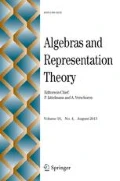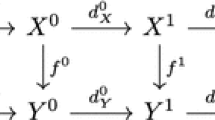Abstract
It is shown that a general concept of Morita duality between abelian categories with no generating hypothesis for reflexive objects is completely described by a special class of quasi-abelian categories, called ample Morita categories. The duality takes place between a pair of intrinsic abelian full subcategories which exist for any quasi-abelian category. Morita categories, being slightly more general, admit a natural embedding into ample ones. An existence criterion for a duality of a Morita category is proved. It generalizes Pontrjagin duality for the category of locally compact abelian groups which is shown to be a non-ample non-classical Morita category. More examples of non-classical Morita categories are obtained from dual systems of topological vector spaces satisfying the Hahn-Banach property.
Similar content being viewed by others
Data Availability
Data sharing not applicable to this article as no datasets were generated or analysed during the current study.
References
Anderson, F.W., Fuller, K.R.: Rings and Categories of Modules. Springer, New York - Heidelberg - Berlin (1974)
Angeleri Hügel, L., Coelho, F.U.: Infinitely generated tilting modules of finite projective dimension. Forum Math. 13(2), 239–250 (2001)
Ánh, P. N., Menini, C.: Morita duality for rings with local units. J. Algebra 164(3), 632–641 (1994)
Ánh, P.N., Wiegandt, R.: Morita duality for Grothendieck categories. J. Algebra 168(1), 273–293 (1994)
Anzai, H., Kakutani, S.: Bohr compactifications of a locally compact Abelian group. I Proc. Imp. Acad. Tokyo 19, 476–480 (1943)
Auslander, M.: Representation dimension of Artin algebras Queen Mary College Mathematics Notes (1971)
Azumaya, G.: A duality theory for injective modules, (Theory of quasi-Frobenius modules). Amer. J. Math. 81, 249–278 (1959)
Chuang, J., Lazarev, A., Mannan, W.: Koszul-Morita duality. J. Noncommut. Geom. 10(4), 1541–1557 (2016)
Colby, R.R., Fuller, K.R.: Exactness of the double dual and Morita duality for Grothendieck categories. J. Algebra 82(2), 546–558 (1983)
Colby, R.R., Fuller, K.R.: QF-3′ rings and Morita duality. Tsukuba J. Math. 8(1), 183–188 (1984)
Colpi, R., Fuller, K.R.: Cotilting modules and bimodules. Pacific J. Math. 192(2), 275–291 (2000)
Colby, R.R., Fuller, K.R.: Equivalence and Duality for Module Categories with Tilting and Cotilting for Rings Cambridge Tracts in Mathematics, vol. 161. Cambridge University Press, Cambridge (2004)
Curtis, C.W.: On commuting rings of endomorphisms. Canadian J. Math. 8, 271–292 (1956)
Curtis, C.W., Reiner, I.: Representation Theory of Finite Groups and Associative Algebras Pure and Applied Mathematics, vol. XI. Interscience Publishers, New York-London (1962)
Dieudonné, J.: La dualité dans les espaces vectoriels topologiques. Ann. Sci. É,cole Norm. Sup. 59, 107–139 (1942)
Enache, P., Năstăsescu, C., Torrecillas, B.: Topological linear compactness for Grothendieck categories. Theorem of Tychonoff. Applications to coalgebras. Publ. Mat. 50(1), 57–70 (2006)
Freyd, P.J., Kelly, G.M.: Categories of continuous functors. I J. Pure Appl. Algebra 2, 169–191 (1972)
Freyd, P.J., Kelly, G.M.: erratum: “Categories of continuous functors, I”. J. Pure Appl. Algebra 4, 121 (1974)
Gómez Pardo, J.L., Guil Asensio, P.A.: Linear compactness and Morita duality for Grothendieck categories. J. Algebra 148(1), 53–67 (1992)
Gómez Pardo, J.L., Guil Asensio, P.A.: Morita duality for Grothendieck categories. Publ. Mat. 36 (1992)(2A), 625–635 (1993)
Gómez-Torrecillas, J., Năstăsescu, C., Torrecillas, B.: Localization in coalgebras, Applications to finiteness conditions. J. Algebra Appl. 6(2), 233–243 (2007)
Koike, K., Morita duality and ring extensions, J. Algebra Appl. 12 (2013), no. 2, 1250160, 23 pp
Mac Lane, S.: Duality for groups. Bull. Amer. Math. Soc. 56, 485–516 (1950)
Mac Lane, S.: Categories for the working mathematician new york - heidelberg - berlin (1971)
Magajna, B.: Injective cogenerators among operator bimodules. Houston J. Math. 33(4), 1091–1115 (2007)
Mantese, F., Tonolo, A.: Natural dualities. A.gebr. Represent. Theory 7(1), 43–52 (2004)
Morita, K.: Duality for modules and its applications to the theory of rings with minimum condition. Sci. Rep. Tokyo Kyoiku Daigaku Sect. A 6, 83–142 (1958)
Morita, K., Tachikawa, H.: Character modules, submodules of a free module, and quasi-Frobenius rings. Math. Z. 65, 414–428 (1956)
Müller, B.J.: On Morita duality. Canadian J. Math. 21, 1338–1347 (1969)
Müller, B.J.: Linear compactness and Morita duality. J. Algebra 16, 60–66 (1970)
Müller, B.J.: Duality theory for linearly topologized modules. Math. Z. 119, 63–74 (1971)
Negrepontis-Pelletier, J.W.: Duality in analysis from the point of view of triples. J. Algebra 19, 228–253 (1971)
Osofsky, B.L.: A generalization of quasi-Frobenius rings. J. Algebra 4, 373–387 (1966)
Ohtake, K.: Morita duality for Grothendieck categories and its application. J. Algebra 174(3), 801–822 (1995)
Popescu, N.: Abelian categories with applications to rings and modules london - new york (1973)
Quillen, D.: Higher Algebraic K-theory, I. In: Algebraic K-Theory, I: Higher K-Theories (Proc. Conf., Battelle Memorial Inst., Seattle, Wash., 1972), Pp. 85-147, Lecture Notes in Math, p 341. Springer, Berlin (1973)
Robertson, L., Schreiber, B.M.: The additive structure of integer groups and p-adic number fields. Proc. Amer. Math. Soc. 19, 1453–1456 (1968)
Rudin, W.: Fourier analysis on groups, Reprint of the 1962 original, Wiley Classics Library, John Wiley & Sons, Inc. New York (1990)
Rump, W.: Almost abelian categories. Cahiers de topologie et gé,ométrie différentielle catégoriques XLII, pp. 163–225 (2001)
Rump, W.: The abelian closure of an exact category. J. Pure Appl. Algebra 224(10), 106395 (2020)
Schaefer, H.H.: Topological Vector Spaces Graduate Texts in Mathematics, vol. 3. Springer-Verlag, New York-Berlin (1971)
Schneiders, J.-P. : Quasi-abelian categories and sheaves, Mém. Soc. Math. France 1999, no. 76
Serre, J.-P.: Groupes d’homotopie et classes de groupes abéliens. Ann. of Math. 58, 258–294 (1953)
Tachikawa, H.: Quasi-Frobenius Rings and Generalizations, QF-3 and QF-1 Rings, Notes by Claus Michael Ringel Lecture 5 in Mathematics, vol. 351. Springer-Verlag, Berlin-New York (1973)
Tonolo, A.: Generalizing Morita duality: a homological approach. J. Algebra 232(1), 282–298 (2000)
Watts, C.E.: Intrinsic Characterizations of some Additive Functors. Proc. Amer. Math Soc. 11, 5–8 (1960)
Weyl, H.: Commutator algebra of a finite group of collineations. Duke Math. J. 3(2), 200–212 (1937)
Weyl, H.: The classical groups, their invariants and representations, princeton university press, princeton N.J. (1939)
Wisbauer, R.: Cotilting Objects and Dualities, Representations of Algebras (São Paulo, 1999), 215-233, Lecture Notes in Pure and Appl Math., vol. 224. Dekker, New York (2002)
Acknowledgements
The author is grateful to an anonymous referee for spotting typos and suggesting a better terminology with respect to Colby-Fuller duality and its covariant generalization in this paper.
Author information
Authors and Affiliations
Corresponding author
Additional information
Presented by: Kenneth Goodearl
Publisher’s Note
Springer Nature remains neutral with regard to jurisdictional claims in published maps and institutional affiliations.
Dedicated to B. V. M.
Rights and permissions
About this article
Cite this article
Rump, W. Morita duality emerging from quasi-abelian categories. Algebr Represent Theor 25, 1309–1322 (2022). https://doi.org/10.1007/s10468-021-10068-4
Received:
Accepted:
Published:
Issue Date:
DOI: https://doi.org/10.1007/s10468-021-10068-4



